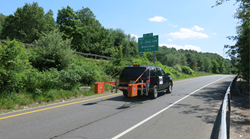Infrasense, Inc., a national leader in ground penetrating radar and infrared thermography bridge deck surveys, recently evaluated two bridges with ground penetrating radar (GPR) in Thomaston, Connecticut. The two bridges measure 554 and 589 feet in length, both bridges support three lanes of traffic. The purpose of the condition surveys was to quantify and map concrete deterioration to facilitate rehabilitation design plans. In addition to the GPR deck condition survey, concrete cores were taken from the bridge deck, piers, and abutments for visual inspection, compressive strength testing, and chloride ion content and water-soluble ion content testing.
 All of Infrasense’s GPR data is collected at highway speeds, making it the fastest nondestructive testing technology to estimate rebar depth, corrosion conditions, and deteriorated concrete. The GPR data was collected with a series of longitudinal passes, each spaced not more than 3 feet transversely across the width of the deck. Using this pattern, 6 lines of data were collected in each direction, each representing a cross sectional slice of the deck at a specified offset. The GPR survey conducted on the Route 8 bridge decks was carried out at normal driving speeds, thus no traffic control was required. After completing the GPR data collection, the undersides of the bridge decks were observed.
All of Infrasense’s GPR data is collected at highway speeds, making it the fastest nondestructive testing technology to estimate rebar depth, corrosion conditions, and deteriorated concrete. The GPR data was collected with a series of longitudinal passes, each spaced not more than 3 feet transversely across the width of the deck. Using this pattern, 6 lines of data were collected in each direction, each representing a cross sectional slice of the deck at a specified offset. The GPR survey conducted on the Route 8 bridge decks was carried out at normal driving speeds, thus no traffic control was required. After completing the GPR data collection, the undersides of the bridge decks were observed.
The potential areas of rebar corrosion and deteriorated concrete are identified by a threshold, which for this project was initially calculated from the GPR data and then refined using the core and chloride test data. GPR deterioration maps have proven to correlate very well with chloride ion concentration levels, and reasonably well with observed corrosion and delamination in extracted core specimens.
GPR, coring, and visual inspection data provide transportation agencies with accurate and comprehensive bridge deck condition information, enabling effective preservation, rehabilitation, and replacement decisions. Since the mechanisms of deterioration occur below the surface, subsurface investigation is most effective to evaluate the estimated lifetime of these bridges.
About Infrasense, Inc.
Since 1987, Infrasense, Inc. has applied state-of-the-art technologies to address the most difficult challenges in subsurface scanning. Infrasense’s engineers are able to nondestructively extract critical information from a diverse range of structures. In addition to providing ongoing subsurface evaluation services to clients across the country, the firm has also conducted numerous research programs to advance the field of subsurface detection and non-destructive evaluation.